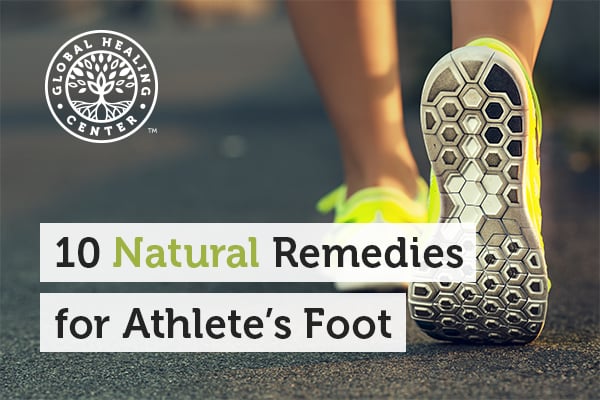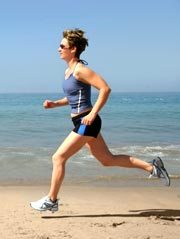
Athlete's foot is a fungal infection that usually thrives in warm, damp places. The fungus, Tinea pedis, grows between the toes, on top of the feet, on toenails and between the fingers. White patches, scaly patches, and redness are all indicative of the fungus. Symptoms of athlete's foot may include itching, burning, and stinging.
Athlete’s foot fungus frequents public showers and locker rooms, indoor swimming pools, and health clubs and it is highly contagious. Contact with shoes or socks, wet floors, or exercise equipment (it can live between fingers) can cause it to spread.
Tips for Preventing Athlete's Foot
You can deter athlete’s foot fungus from taking hold by wearing flip-flops around public pools or showers and ensuring that your feet, including between your toes, are thoroughly dried after bathing or swimming. You should keep your toenails the shortest length that is comfortable since the fungus can live under toenails. Long toenails can retain moisture and provide a haven for the fungus. Avoid wearing sweaty socks or shoes any longer than you must.
If your feet sweat a lot during the day, or if you are particularly active, take a fresh pair of organic cotton socks with you and change them partway through the day (cotton is more absorbent than synthetic materials and better for your feet), and don’t wear the same shoes the following day. Give them time to completely dry and air out. If you can, sleep barefoot with your feet out of the covers — this will also help to keep them dry and make them less hospitable to the fungus.
10 Natural Remedies for Athlete's Foot
While prevention is always the best medicine, it’s not a fail-safe. If you do find yourself with itchy feet, here are some natural remedies that can help with athlete’s foot.

1. Tea Tree Oil
Add 40 Drops of Organic Tea Tree Oil to a foot bath and soak your feet for 10 minutes. After soaking and thoroughly drying the feet, massage a few drops of the oil directly into the affected area. Tea tree oil has properties that will help destroy the fungus in heavily infested areas and deter it from spreading to unaffected areas.[1]
2. Himalayan Crystal Salt and Apple Cider Vinegar
Soak your feet in 2 tablespoons of Himalayan Crystal salt and ½ cup Organic Apple Cider Vinegar solution mixed with some warm water.[2] Vinegar creates a very acidic environment in which fungus cannot live.[3] You can also spray your feet or wipe them down with a cloth soaked in this solution after you shower, just make sure you get them completely dry afterward. You can also wipe down the insides of shoes and sandals to help prevent the fungus from clinging there.
3. Garlic
Make your feet stinkier by placing slices of fresh garlic, or some crushed garlic, between your toes and leaving them there for the day. Allicin, the active compound in garlic, inhibits the growth of the fungus Trichophyton rubrum, the most common cause of athlete’s foot.[4] You can also add the garlic to foods you eat or take a garlic supplement for the same effect, but it may take a little bit longer.
4. Neem Oil
Organic neem oil, sometimes used as a pesticide, is another all-natural oil that is toxic to harmful organisms.[5] Apply to clean, dry feet with a cotton ball.
5. Corn Starch and Baking Soda
Sprinkle your toes with a little bit of organic corn starch or baking soda before putting on your socks in the morning. The corn starch or baking soda won’t stop the itch, but it will help soak up moisture. Baking soda in the shoes also absorbs some of that not-so-pleasant sweaty foot smell.
6. Oregano Oil
Oregano contains essential oils that act against harmful organisms.[6] Make a tea of 4 ounces of oregano leaves and just enough water to cover your feet. Soak your feet 2-3 times daily in this mixture. Some people say that you can re-use this tea for a week, but I recommend making it fresh each day.
7. Sesame and Coconut Oil
Both sesame and raw virgin coconut oil have antifungal properties[7, 8] and can be applied directly to the feet. Swab liberally on clean, dry feet with a cotton ball twice daily.
8. Ginger
You can also use organic ginger, just an ounce of fresh chopped ginger added to a cup of boiling water and simmered for 20 minutes. Once cooled, apply twice daily to clean feet. Ginger is a strong antifungal, and your feet will have a pleasantly spicy smell.[9]
9. Ozonated Olive Oil
A relatively new therapy, ozonated olive oil, can also help with athlete’s foot. Ozone is a proven antifungal agent and can help heal damaged skin.[10] Apply the paste to clean, dry feet each morning and night. This should clear up the fungus within two to four days and can discourage future outbreaks. I recommend an ozonated oil paste made with organic, cold-pressed olive oil such as Global Healing's Skin Therapy.
10. Colloidal Silver
Colloidal Silver is another common remedy for athlete’s foot with known antifungal properties.[11] Spray or apply to your feet and let it fully dry. Alternatively, you can spray and leave the silver on your feet overnight. There are a lot of hucksters peddling shoddy colloidal silver. Only buy a high-quality product from a reputable company.
References (11)
- Nenoff, P, et al. "Antifungal Activity of the Essential Oil of Melaleuca Alternifolia (tea Tree Oil) Against Pathogenic Fungi in Vitro." Skin Pharmacology : The Official Journal of the Skin Pharmacology Society., vol. 9, no. 6, 1 Jan. 1996, pp. 388–94. Accessed 28 Feb. 2017.
- Young, Brigham. "L. Tom Perry Special Collections: Burns." BYU Harold B. Lee Library, 11 Feb. 2014. Accessed 28 Feb. 2017.
- Mota, AC, et al. "Antifungal Activity of Apple Cider Vinegar on Candida Species Involved in Denture Stomatitis." Journal of Prosthodontics: Official Journal of the American College of Prosthodontists., vol. 24, no. 4, 16 Sept. 2014, pp. 296–302. Accessed 28 Feb. 2017.
- Aala, Farzad et al. "Inhibitory Effect of Allicin and Garlic Extracts on Growth of Cultured Hyphae." Iranian Journal of Basic Medical Sciences 17.3 (2014): 150–154. Print.
- Mahmoud, D.A. et al. "Antifungal Activity of Different Neem Leaf Extracts and the Nimonol against Some Important Human Pathogens." Brazilian Journal of Microbiology 42.3 (2011): 1007–1016. PMC. Web. 28 Feb. 2017.
- "Some Common Spices and Plants with Antimicrobial and Therapeutic Properties." University of Hawaiʻ. Accessed 28 Feb. 2017.
- Ogawa, T, et al. "Effect of Edible Sesame Oil on Growth of Clinical Isolates of Candida Albicans." Biological Research for Nursing., vol. 16, no. 3, 24 Sept. 2013, pp. 335–43, Accessed 28 Feb. 2017.
- Ogbolu, DO, et al. "In Vitro Antimicrobial Properties of Coconut Oil on Candida Species in Ibadan, Nigeria." Journal of Medicinal Food., vol. 10, no. 2, 27 July 2007, pp. 384–7. Accessed 28 Feb. 2017.
- Tagoe, Daniel, et al. "A Comparison Of The Antimicrobial (Antifungal) Properties Of Garlic, Ginger And Lime On Aspergillus Flavus, Aspergillus Niger And Cladosporium Herbarum Using Organic And Water Base Extraction Methods." The Internet Journal of Tropical Medicine, vol. 7, no. 1, 2010.
- Kim, Hee Su et al. "Therapeutic Effects of Topical Application of Ozone on Acute Cutaneous Wound Healing." Journal of Korean Medical Science 24.3 (2009): 368–374. PMC. Web. 28 Feb. 2017.
- Monteiro, et al. "Silver Colloidal Nanoparticles: Antifungal Effect Against Adhered Cells and Biofilms of Candida Albicans and Candida Glabrata." Biofouling., vol. 27, no. 7, 16 July 2011, pp. 711–9. Accessed 28 Feb. 2017.
†Results may vary. Information and statements made are for education purposes and are not intended to replace the advice of your doctor. If you have a severe medical condition or health concern, see your physician.







